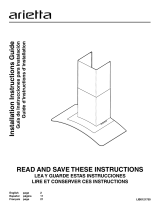
22
22
2
Please read and save this guide
Thank you for choosing
ElectrElectr
ElectrElectr
Electr
oluxolux
oluxolux
olux, the new premium brand in home appliances. This
Use & Care Guide
is
part of our commitment to customer satisfaction and product quality throughout the service life of your new
appliance.
We view your purchase as the beginning of a relationship. To ensure our ability to continue serving you,
please use this page to record important product information.
Keep a rKeep a r
Keep a rKeep a r
Keep a r
ecorecor
ecorecor
ecor
d for quick rd for quick r
d for quick rd for quick r
d for quick r
eferefer
eferefer
efer
enceence
enceence
ence
Finding Information
NOTE
Registering your product with Electrolux enhances
our ability to serve you. You can register online at
wwwwww
wwwwww
www
.electr.electr
.electr.electr
.electr
oluxusa.comoluxusa.com
oluxusa.comoluxusa.com
oluxusa.com or by dropping your
Product Registration Card in the mail.
Questions?
For toll-free telephone support in the U.S. and Canada:
1-877-4ELECTROLUX (1-877-435-3287)1-877-4ELECTROLUX (1-877-435-3287)
1-877-4ELECTROLUX (1-877-435-3287)1-877-4ELECTROLUX (1-877-435-3287)
1-877-4ELECTROLUX (1-877-435-3287)
For online support and Internet product information visit http://
wwwwww
wwwwww
www
.electr.electr
.electr.electr
.electr
oluxusa.comoluxusa.com
oluxusa.comoluxusa.com
oluxusa.com
Table of contents
Important Safety InstructionsImportant Safety Instructions
Important Safety InstructionsImportant Safety Instructions
Important Safety Instructions
......................................................
......................................................
...........................
3-43-4
3-43-4
3-4
Electrical & Installation rElectrical & Installation r
Electrical & Installation rElectrical & Installation r
Electrical & Installation r
equirequir
equirequir
equir
ementsements
ementsements
ements
........................................
........................................
....................
55
55
5
Electrical requirements.......................................... 5
IMPORTANT ......................................................... 5
Before installing the hood ..................................... 5
List of MaterialsList of Materials
List of MaterialsList of Materials
List of Materials
......................................................................................................
......................................................................................................
...................................................
66
66
6
Parts Included with your Hood .............................. 6
Optional Accessories ............................................ 6
Tools/Materials required ........................................ 6
Installing the hoodInstalling the hood
Installing the hoodInstalling the hood
Installing the hood
..................................................................................
..................................................................................
.........................................
7-147-14
7-147-14
7-14
Installing preparation............................................. 7
Wall framing for adequate support ........................ 7
Removing the packaging ...................................... 7
Examples of possible ducting ............................... 8
Ductwork installation guidelines ............................ 8
Ductwork and wiring locations .............................. 8
Mounting the duct cover bracket .......................... 9
Ceiling ducting.................................................... 10
Wall ducting........................................................ 10
House wiring location ......................................... 10
Install framing for hood support .......................... 10
Mounting the hood ............................................. 11
Connecting the ductwork ................................... 12
Air deflector installation
(Recirculating accessories) .................................. 12
Making the electrical connections ....................... 13
Mounting the glass canopy ................................. 13
Mounting the duct cover ..................................... 14
FeaturFeatur
FeaturFeatur
Featur
eses
eses
es
........................................................................................................................
........................................................................................................................
............................................................
1515
1515
15
ContrContr
ContrContr
Contr
ol buttonsol buttons
ol buttonsol buttons
ol buttons
..................................................................................................
..................................................................................................
.................................................
1616
1616
16
Special functionsSpecial functions
Special functionsSpecial functions
Special functions
..............................................................................................
..............................................................................................
...............................................
1717
1717
17
Clock programming ............................................ 17
Grease filter saturation alarm............................... 17
Charcoal filter saturation alarm
(Recirculating accessories) .................................. 17
Audible signal activation and deactivation ........... 17
Charcoal filter inclusion and exclusion
(Recirculating accessories) .................................. 17
Heat sensor ........................................................ 17
For Best results .................................................. 18
CarCar
CarCar
Car
e and cleaninge and cleaning
e and cleaninge and cleaning
e and cleaning
..........................................................................................
..........................................................................................
.............................................
1919
1919
19
Filters ................................................................. 19
Lights ................................................................. 19
Optional Charcoal Filters ..................................... 20
Hood Surface ..................................................... 20
WW
WW
W
arranty Informationarranty Information
arranty Informationarranty Information
arranty Information
..................................................................................
..................................................................................
.........................................
2121
2121
21
©2007 Electrolux Home Products, Inc.
All rights reserved. Printed in Mexico
Purchase date
Electrolux model number
Electrolux serial number (see picture for location)





















